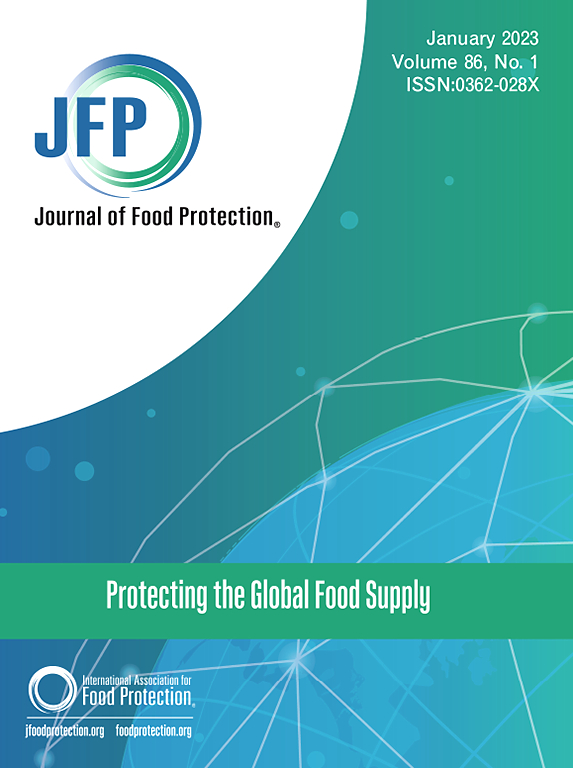干货包装车间的交叉污染风险:酒精基杀菌剂减少相关表面材料上沙门氏菌和潜在替代品的功效
IF 2.1
4区 农林科学
Q3 BIOTECHNOLOGY & APPLIED MICROBIOLOGY
引用次数: 0
摘要
2020年沙门氏菌爆发在流行病学上与红洋葱有关;然而,由于包装车间的清洁和卫生条件不足,召回范围扩大到该包装车间在前3个月处理过的所有洋葱。我们的目的是评估干式杀菌剂在减少收获后包装区域食品接触面交叉污染风险方面的功效。对沙门氏菌和潜在的替代菌(大肠杆菌、屎肠球菌)在洋葱中的转移和从洋葱到FCS材料(高密度聚丙烯、聚酯-尼龙传送带、胶合板)的转移进行了量化。从接种洋葱到FCS的转移率变化很大,但表面差异不大,平均为-1.19 log %。受污染的FCS向未接种洋葱的转移率平均为0.2 log %,其中40%(31/81)的洋葱没有可检测到的转移。洋葱品种、表面类型和品种对转移率无显著影响(p < 0.05)。测试了商业消毒剂和酒精溶液减少FCS上目标细菌的功效。30s后和干燥15min后定量测定还原量。高酒精消毒剂(约60%)干燥后HDPE减少了5倍。低度酒精(本文章由计算机程序翻译,如有差异,请以英文原文为准。
Cross-contamination Risks in Dry Produce Packinghouses: Efficacy of Alcohol-based Sanitizers to Reduce Salmonella and Potential Surrogates on Relevant Surface Materials
A 2020 Salmonella outbreak was epidemiologically linked to red onions; however, insufficient cleaning and sanitation in the packinghouse expanded the recall to include all onions handled by the packing house in the preceding 3 months. Our objective was to evaluate the efficacy of dry sanitizers to reduce cross-contamination risk on food contact surfaces (FCSs) found in postharvest packing areas. Transfer of Salmonella and potential surrogates (Escherichia coli, Enterococcus faecium) to and from onions to FCS materials (high-density polypropylene, polyester-nylon conveyor belts, plywood) was quantified. Transfer rates from inoculated onions to FCS were highly variable, but did not differ by surface, averaging −1.19 log %. Transfer rates from contaminated FCS to uninoculated onions averaged 0.2 log %, with 40% (31/81) of onions having no detectable transfer. Onion variety, surface type, and species did not influence the transfer rate (p > 0.05). Commercial sanitizers and alcohol solutions were tested for efficacy of reducing targeted bacteria on FCS. Reductions were quantified after 30 s and after drying (15 min). High alcohol sanitizers (∼60%) achieved a 5-log reduction on HDPE after drying. Lower alcohol (<30%) products were ineffective (<2-log reduction). E. coli and Salmonella were comparable in sensitivity to sanitizers, but E. faecium was more sensitive (p < 0.05). Transfer and sanitizer evaluation was scaled to investigate cross-contamination in postharvest storage bins (plastic and wood). With no sanitation, inoculated plastic bin contact resulted in contamination of 49–71% of onions. Use of ∼60% alcohol solutions reduced contamination to <4% of onions (p < 0.05). Low-alcohol product significantly increased cross-contamination to 86–100% of onions (p < 0.05). These findings highlight the importance of validating sanitizer efficacy to quantify microbial reduction and cross-contamination risk on produce contact surfaces.
求助全文
通过发布文献求助,成功后即可免费获取论文全文。
去求助
来源期刊

Journal of food protection
工程技术-生物工程与应用微生物
CiteScore
4.20
自引率
5.00%
发文量
296
审稿时长
2.5 months
期刊介绍:
The Journal of Food Protection® (JFP) is an international, monthly scientific journal in the English language published by the International Association for Food Protection (IAFP). JFP publishes research and review articles on all aspects of food protection and safety. Major emphases of JFP are placed on studies dealing with:
Tracking, detecting (including traditional, molecular, and real-time), inactivating, and controlling food-related hazards, including microorganisms (including antibiotic resistance), microbial (mycotoxins, seafood toxins) and non-microbial toxins (heavy metals, pesticides, veterinary drug residues, migrants from food packaging, and processing contaminants), allergens and pests (insects, rodents) in human food, pet food and animal feed throughout the food chain;
Microbiological food quality and traditional/novel methods to assay microbiological food quality;
Prevention of food-related hazards and food spoilage through food preservatives and thermal/non-thermal processes, including process validation;
Food fermentations and food-related probiotics;
Safe food handling practices during pre-harvest, harvest, post-harvest, distribution and consumption, including food safety education for retailers, foodservice, and consumers;
Risk assessments for food-related hazards;
Economic impact of food-related hazards, foodborne illness, food loss, food spoilage, and adulterated foods;
Food fraud, food authentication, food defense, and foodborne disease outbreak investigations.
 求助内容:
求助内容: 应助结果提醒方式:
应助结果提醒方式:


